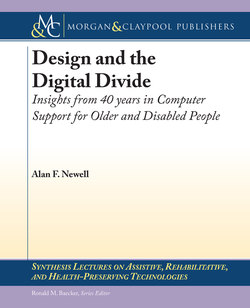Читать книгу Design and the Digital Divide - Alan F. Newell - Страница 8
На сайте Литреса книга снята с продажи.
ОглавлениеContents
Acknowledgments
Foreword
1 40 years–Highlights and a Brief Review
1.1 An interdisciplinary education
1.2 Industry—speech recognition research
1.3 Southampton University—a developing focus on “aids for disabled people”
1.4 A chance meeting with a member of the British Parliament
1.5 Television subtitling
1.6 Dundee University
1.7 The School of Computing
1.8 IT support for older people—The Queen Mother Research Centre
1.9 Theatre for awareness raising and requirements gathering
1.10 Putting one’s faith in stories
1.11 Summary
2 Communication Systems for Non-Speaking and Hearing-Impaired People
2.1 A voice-operated typewriter for physically disabled people
2.2 The talking brooch—a communication aid for non-speaking people
2.3 Speech transcription for deaf people
2.4 Developing a first prototype with no external funding
2.5 Non-technological challenges to implementation
2.6 Technology transfer
2.7 The need for luck, faith, time, and effort
2.8 Commercial availability
3 TV Subtitling for Hearing-Impaired People
3.1 Moving into the field
3.2 The content and cost of television subtitles
3.3 Live subtitling
3.4 A subtitle preparation system
4 Word Prediction for Non-Speaking People and Systems for those with Dyslexia
4.1 Support for non-speaking people
4.2 Developing AAC devices
4.3 Word Prediction and associated techniques
4.4 Prediction supporting dyslexics
4.5 Evaluation of the effectiveness of prediction
4.6 Other techniques to support dyslexics
4.7 Disambiguation
4.8 Beyond word prediction
5 Providing Reusable Conversation for Non-Speaking People
5.1 An application of conversational analysis
5.2 Perceived communication competence
5.3 Technology to assist deceit
5.4 “Chattering, nattering and cheek”
5.5 Differences in conversational styles
5.6 The use of speech act theory
5.7 CHAT—Conversation Helped by Automatic Talk
5.8 Pragmatics versus semantics
5.9 The future
6 Story Telling and Emotion in Synthetic Speech
6.1 What do we do after we have said “Hello”
6.2 TOPIC—Text OutPut in Conversation
6.3 Prose—and other storytelling systems
6.4 Floorgrabber: an aid for non-speaking lecturers
6.5 Other conversational aids
6.6 Jokes
6.7 Symbolic and picture-based communication systems
6.8 Communication aids for Intensive Care
6.9 Emotion in synthetic speech
6.10 The current situation
6.11 The future
7 Lessons Learned from Designing AAC Devices
7.1 An effective and appropriate team
7.2 The role of users in the design team
7.3 Research in a clinical environment
7.4 Composition of a research team
7.5 An appropriate research methodology
7.6 Evaluation techniques
7.7 The cost of assistive technology
7.8 Professionalism in research
7.9 Ethical considerations
7.10 Assistive technology research—a summary
8 IT Systems for Older People
8.1 Introduction
8.2 Cybrarian: an e-mail system designed for older people
8.3 SeniorMail: also designed for older people
8.4 Sustaining the use of CIT
8.5 Assistive Technology for older users
8.6 IT supporting dementia
8.6.1 CIRCA: a multi-media scrap book
8.6.2 Creating music
8.6.3 Aids for daily living
8.7 Social networking for older adults
8.8 The Digital Divide
8.9 Conclusions
9 Designing IT Systems for Older People
9.1 Older people and demographics
9.2 Older people’s use of information technology
9.3 Mainstream information technology and older users
9.4 The characteristics of older people relevant to their use of IT
9.5 Reducing Functionality
9.6 Technical Generation Effect
9.7 Designing for dynamic diversity
9.8 Challenges for today’s young and middle-aged people
10 Ordinary and Extra-Ordinary Human Computer Interaction
10.1 Rehabilitation engineering and HCI
10.2 Mainstream exploitation of assistive technology research
10.3 Ordinary and extra-ordinary people and environments
10.3.1 “Able-bodied” and “disabled”—a false dichotomy
10.3.2 Individual differences
10.3.3 A concentration on real needs
10.3.4 Learning from extreme situations
10.3.5 Handicapping environments
10.3.6 Human computer interface “bandwidth”
10.4 Pitfalls of not considering the needs of people with disabilities
10.5 ECHO and ARCHIE—instantiations of the ordinary and extra-ordinary concepts
10.6 Take-home messages
11 User Sensitive Inclusive Design
11.1 Universal Design/Design for all
11.2 The “Accessibility” approach
11.3 User-centred and participatory design
11.4 Building on Design for All and User Centered Design
11.5 User Sensitive Inclusive Design
11.6 Engaging with users
11.7 Mutual inspiration between researchers and users
11.8 The “User Centre”—a social space for older users
11.9 Formal experiments with older and/or disabled users
11.10 Subject experts and clinicians
11.11 A focus on aesthetics
11.12 A focus on extraordinary users
12 The Use of Professional Theatre
12.1 Awareness raising
12.2 Using professionals
12.3 The UTOPIA trilogy
12.4 Evaluation of the trilogy
12.5 “Relative Confusion”
12.6 “Relatively PC”
12.7 Using live theatre, film and a combination of both
12.8 Theatre in requirements gathering
12.8.1 Smart house technology
12.8.2 Digital television applications for older people
12.8.3 New technology in the work place
12.8.4 Smart houses and multiple stakeholder
12.8.5 Adaptive interfaces
12.9 The use of professional actors to simulate users with dementia
12.10 The value of theatre
13 Attacking the Digital Divide
13.1 The challenge
13.2 The characteristics of older and disabled people
13.3 Build on capacities
13.4 Beware of jet packs
13.5 Technology-led research
13.6 Exploit unconnected research
13.7 Relationships with users
13.8 Hostility
13.9 Interdisciplinary teams
13.10 The need for professionalism in this research and development
13.11 Cognitive decline
13.12 Evaluation techniques
13.13 Other digitally disadvantaged groups
13.14 The challenges faced by older people will not go away
13.15 Concluding thoughts
Bibliography
Author’s Biography
